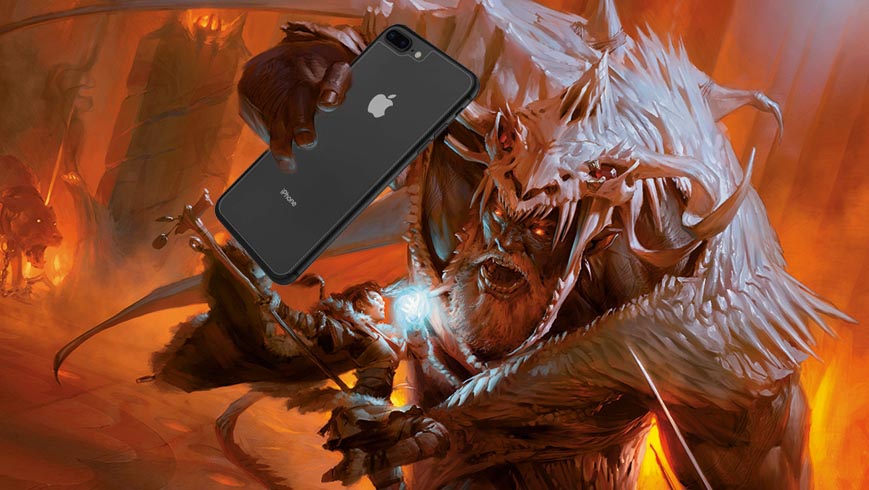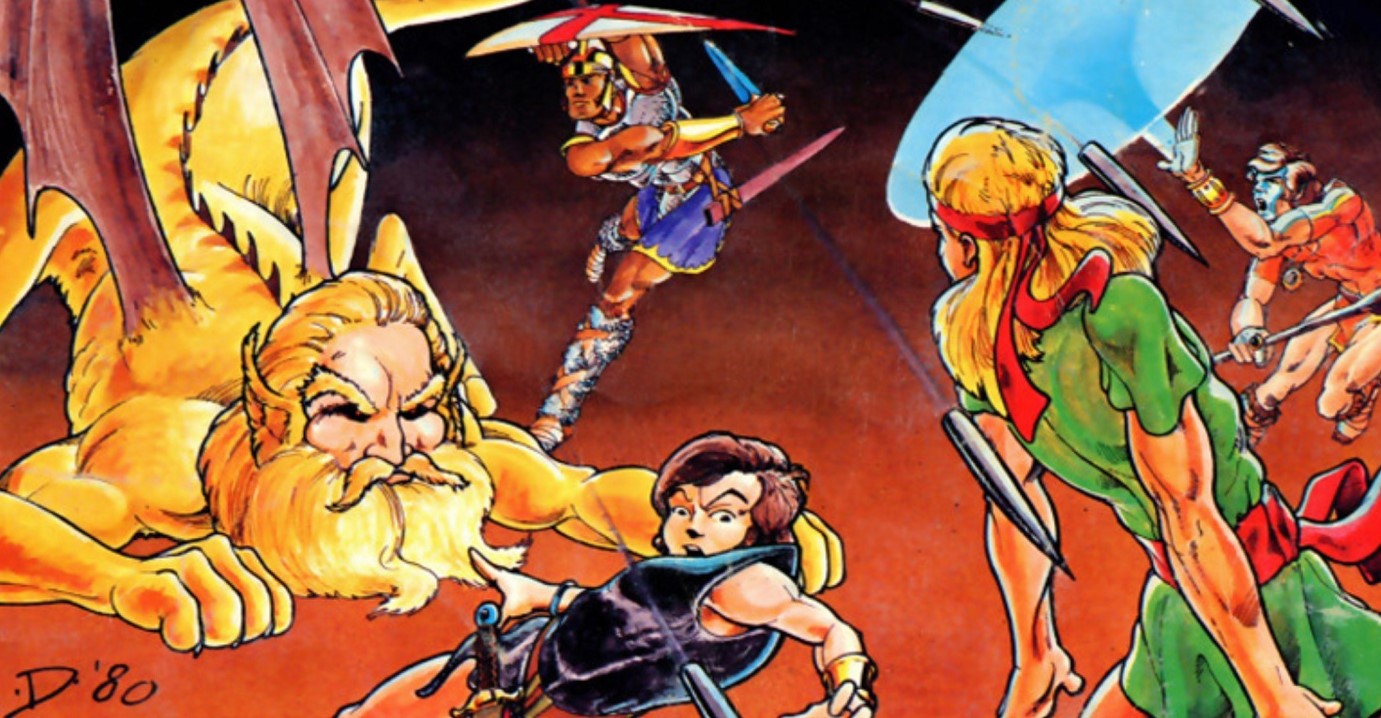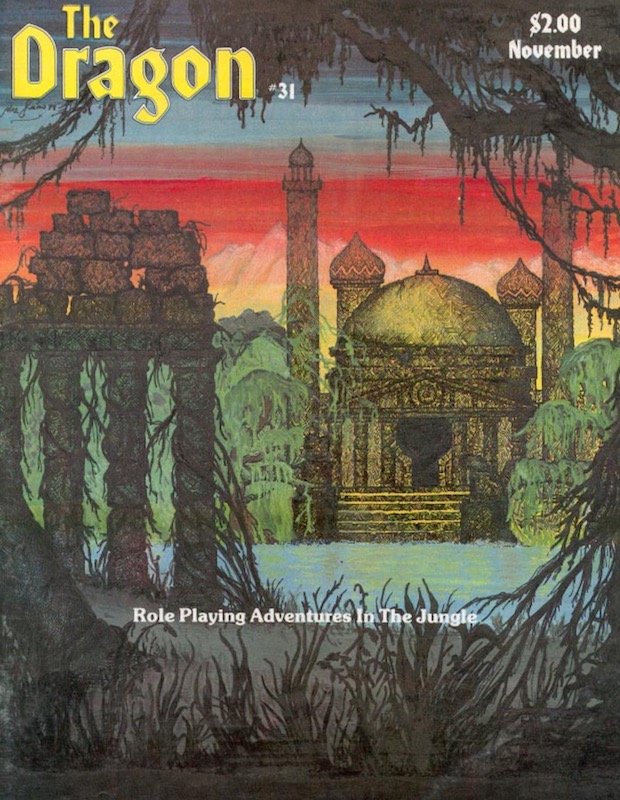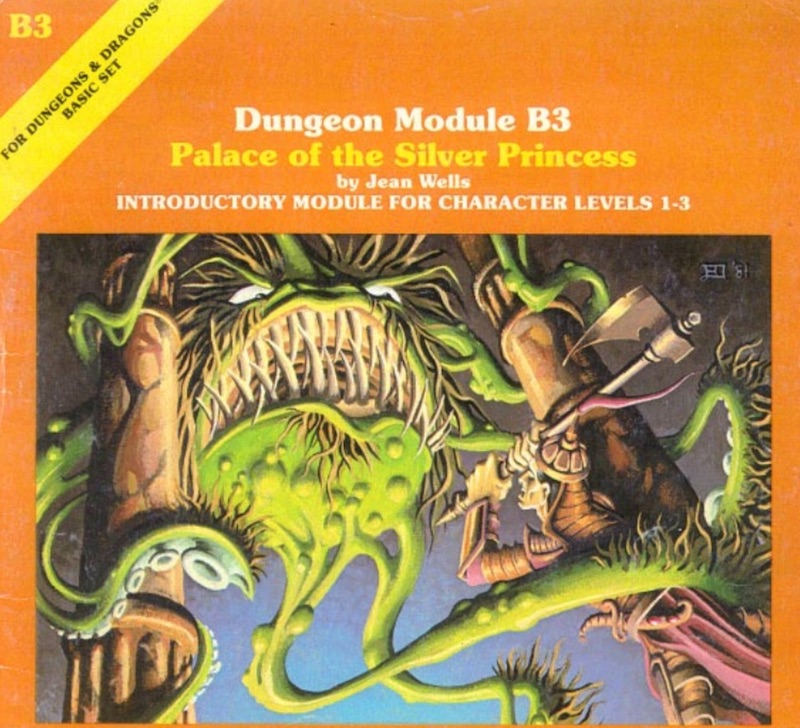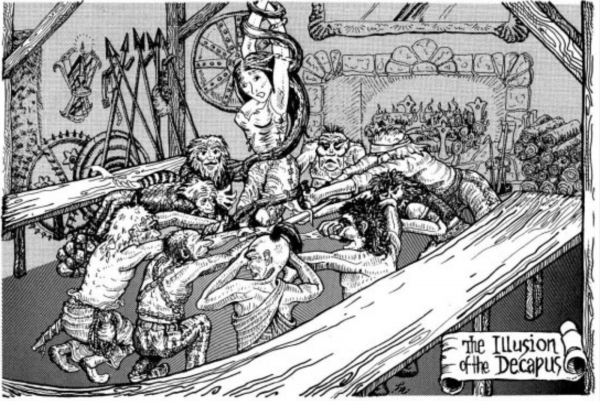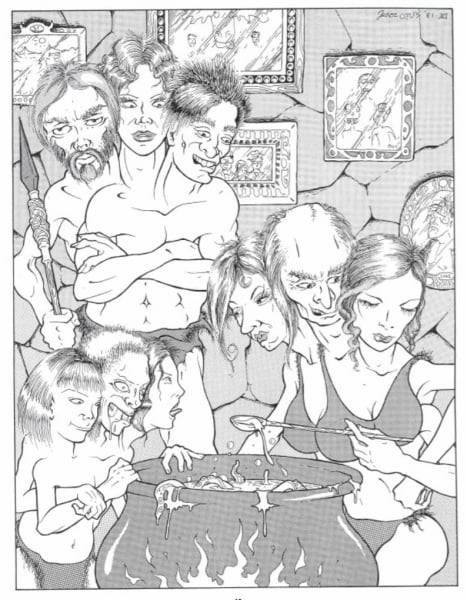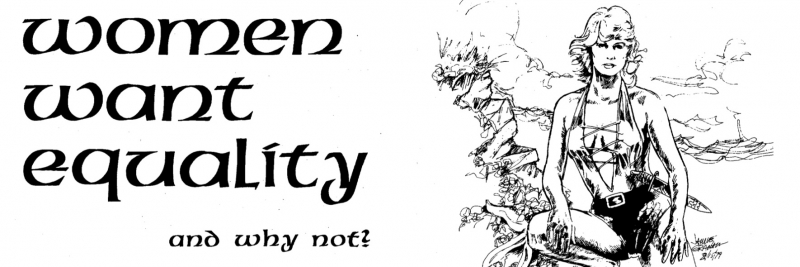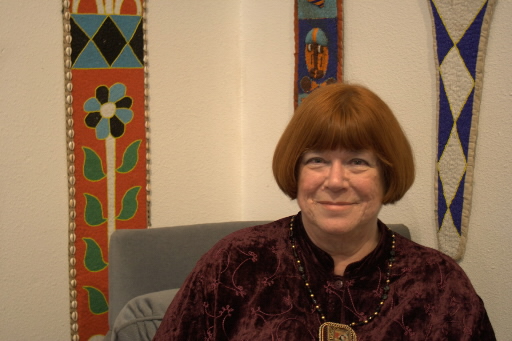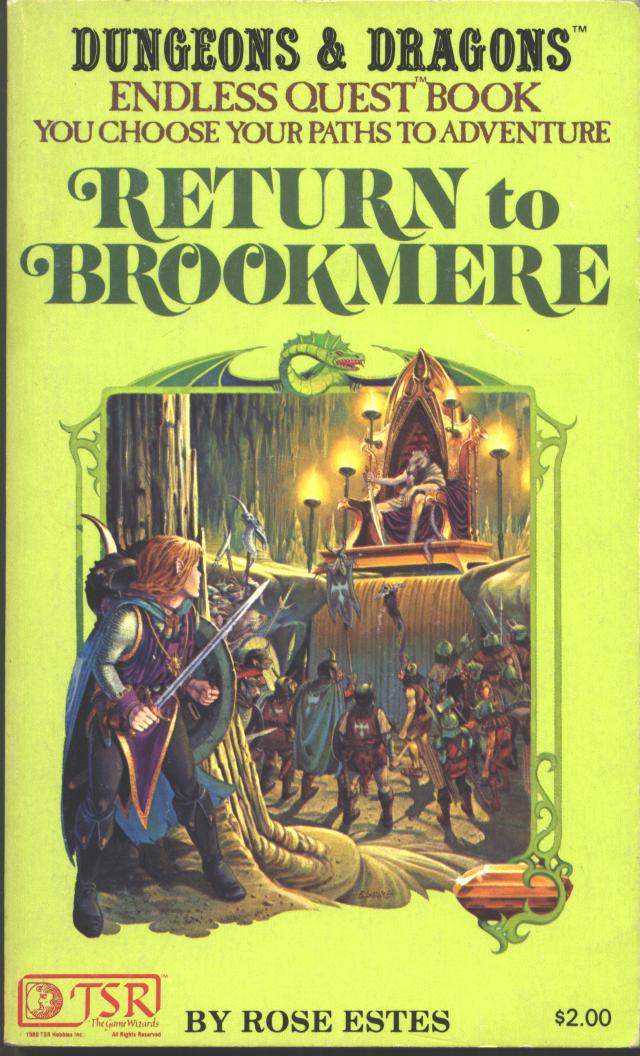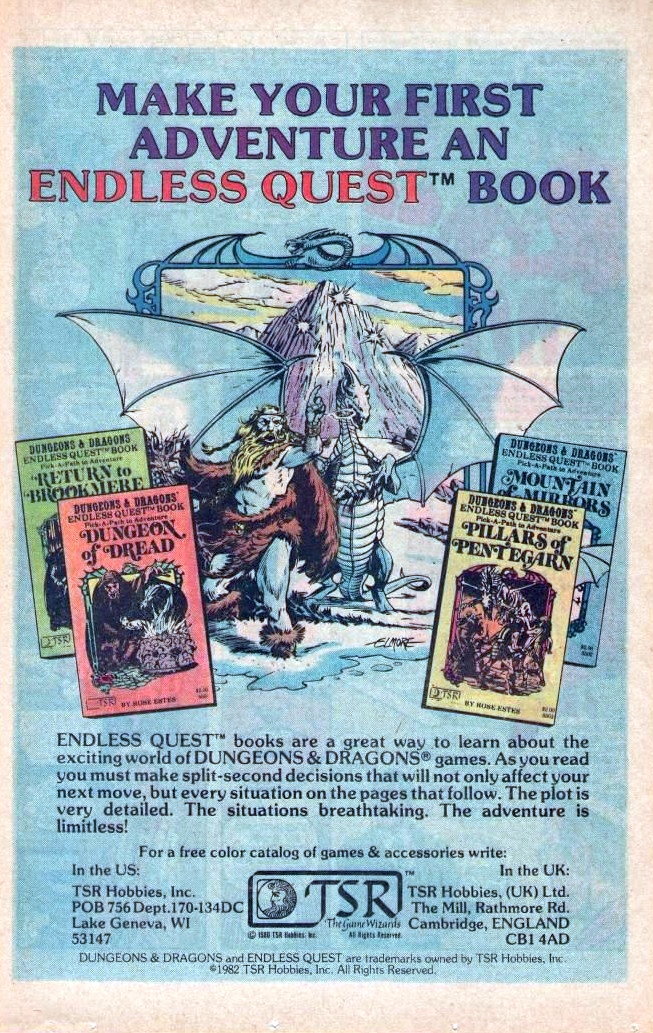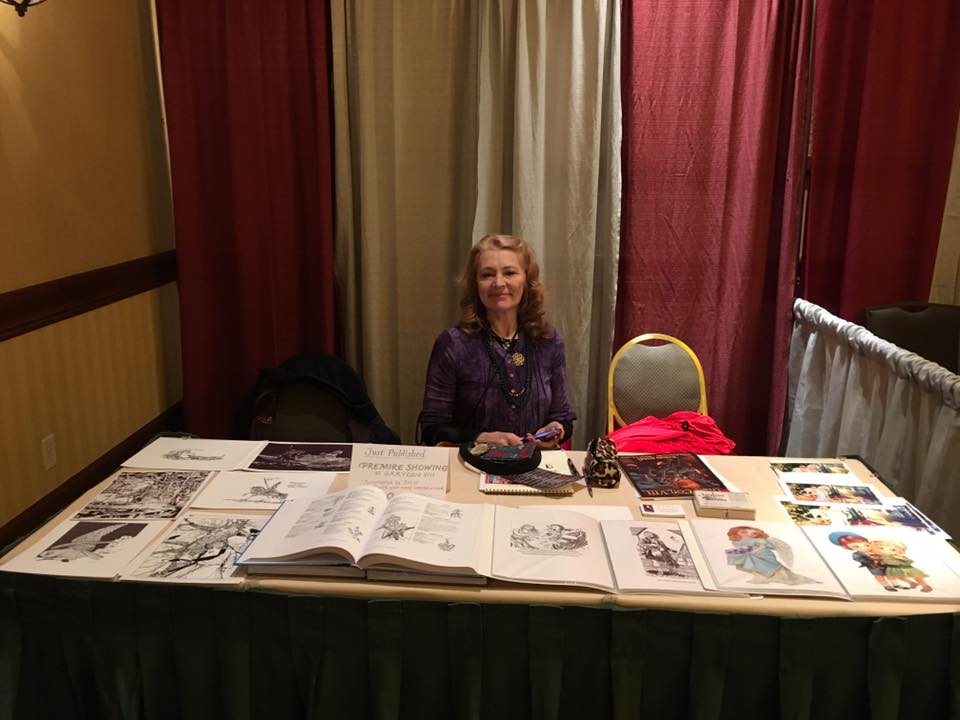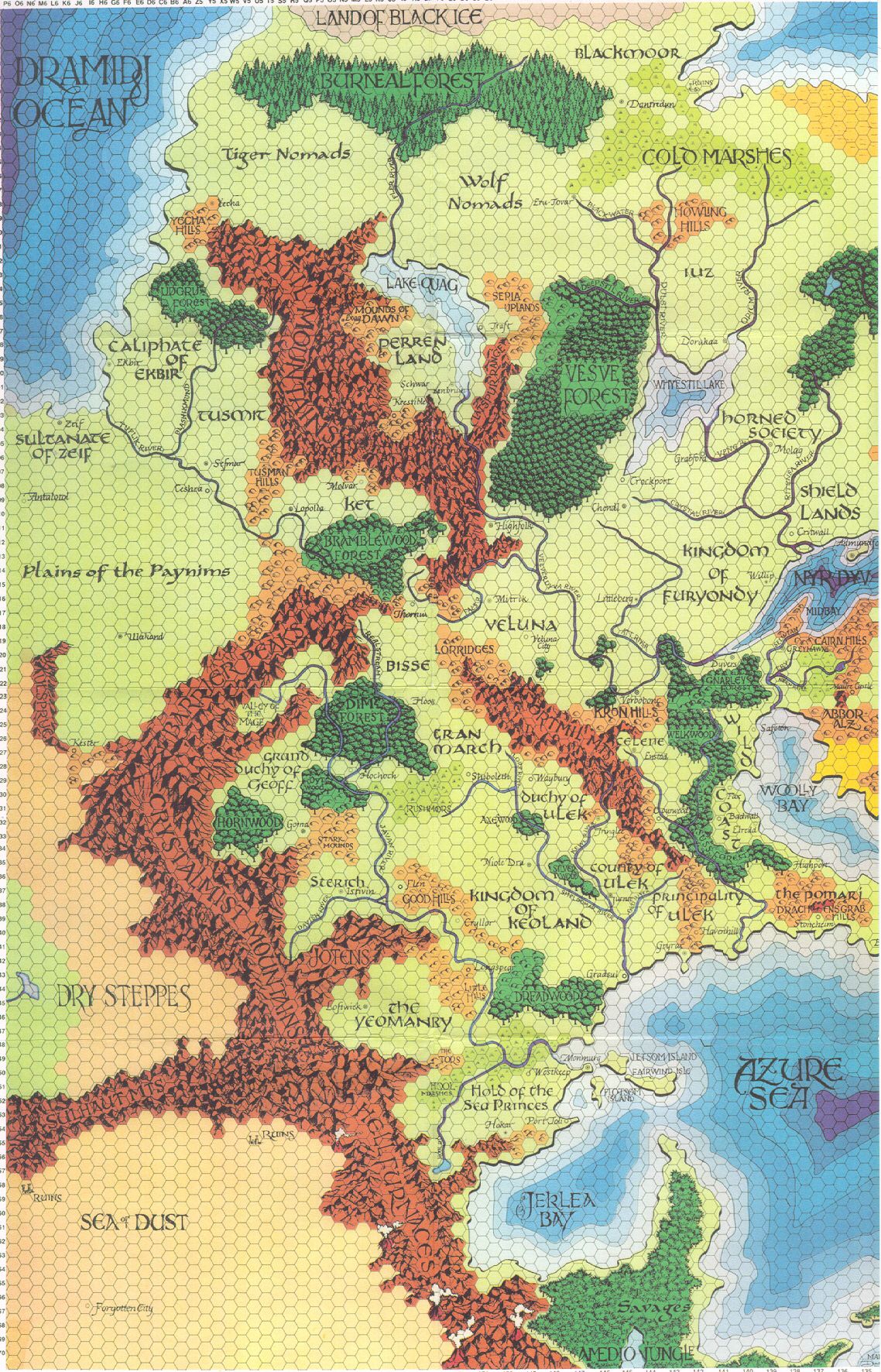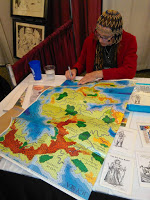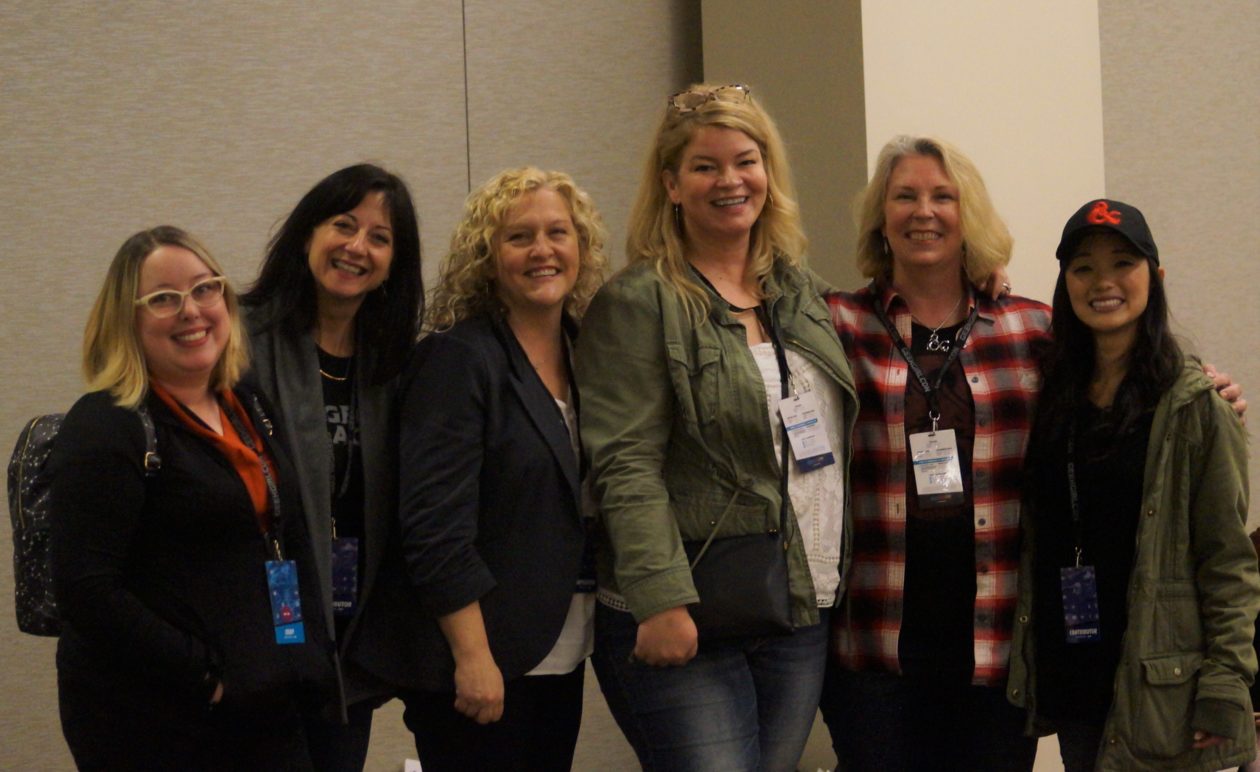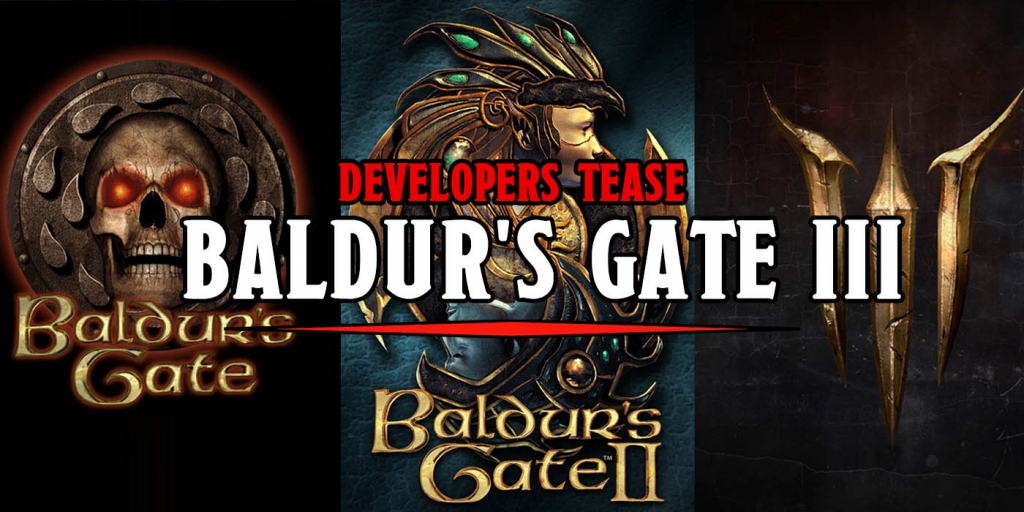D&D: Designing Women Who Defined the Game – Prime
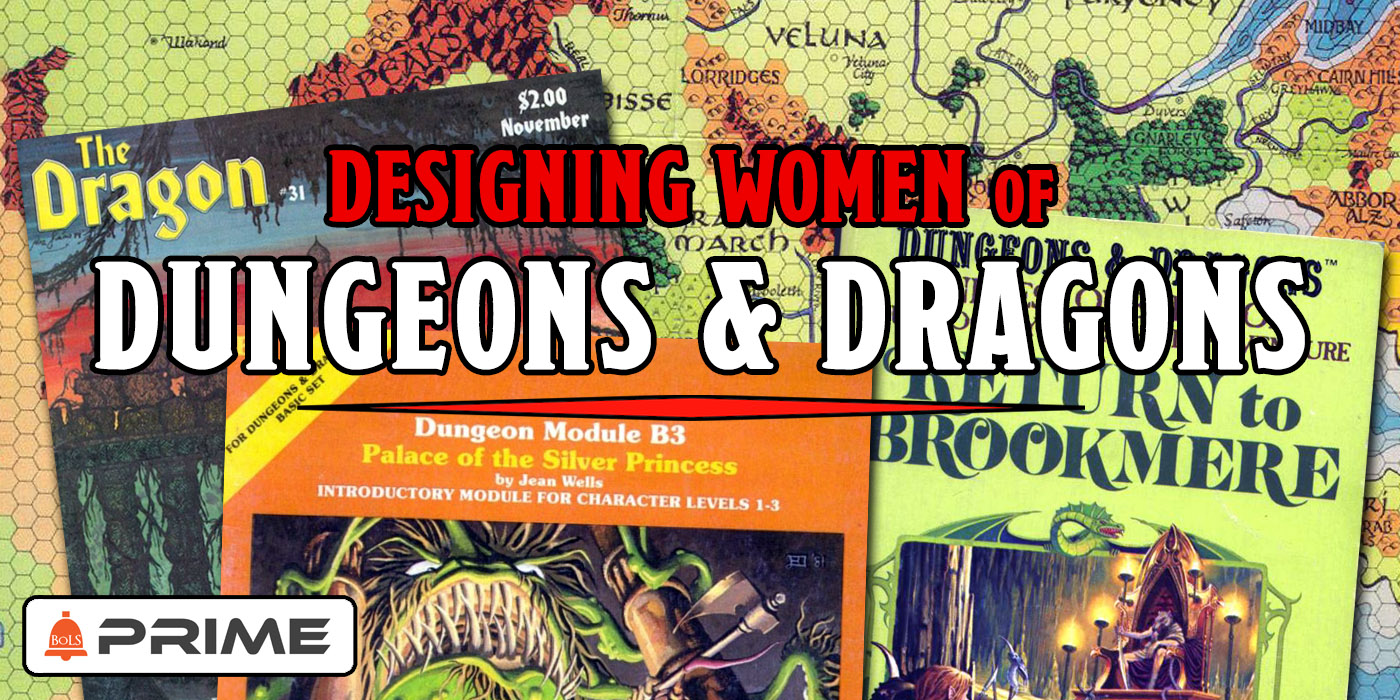
D&D owes much to its early community of creatives and creators–these women helped make D&D the game it is.
Ask anyone to describe a typical D&D player and, well, these days you’ll get a variety of answers–anything from cool people with asymmetrical haircuts or brightly colored hair, to cool people in their 50s with kids and sensible jackets who’ve been playing D&D since the days when you had to worry about being mistaken for a Satanist. This wasn’t always the case. Popular opinion of D&D has been seeing a very literal paradigm shift that went from the FBI’s former description of what D&D/wargaming looks like:
The FBI also had a low opinion of war gamers: pic.twitter.com/kQG9aKzBzA
— CJ Ciaramella (@cjciaramella) June 15, 2017
To the same sort of people that posted their D&D Selfies twice earlier this year in response to disparaging remarks–the first an SNL Skit that had Kit Harrington doing some tremendous character immersion as part of a LARP battle among creepy office tech dudes (who, to be fair, are also the sort to play D&D)–and the second, in response to a devastating call out by MJF, the rising heel-star of the new AEW. Now, a big part of that perception shift comes from the visibility of the internet and its ability to bring together disparate groups of people for better and worse.
People love to point out the diversity and inclusivity of D&D–but it’s by no stretch of the imagination a new phenomenon, despite what a small but vocal part of the internet may think. Go to whatever online community you visit to entertain these fair, well-spoken days (lest you spy your shadow in the sun and descant on your own deformity–and we all know where that leads), and say something about D&D (or RPGs in general, if we’re being fair) and diversity or inclusivity and you’ll find people crawling out of the woodworks to tell you that SJWs are ruining everything these days. They just can’t help it.
It’s a little known fact that Ridley Scot was able to get some of his best shots by setting up cameras on the sets whispering that “including gender-nonconforming characters in your roleplaying games is a good thing” and then just replacing angry commenters with HR Geiger’s artwork. A complicated process, to be sure, but it really captured the realism of the motion.
Disgruntled commenters (and career-defining cinematography) aside though, this “SJW nonsense” is nothing new. What we’re seeing today is the end result of the hard work and dedication of people who have been a part of the community and the industry since its inception. The steady march of social progress might feel like it’s only now catching on, but that ignores the work of those who have, through monumental effort, shifted the bar before them. Here’s a look at the women who helped make Dungeons and Dragons what it is.
Picture courtesy of BlackmoorMystara
Let’s start with Jean Wells, the first woman designer hired by TSR, and author of the most expensive D&D module of all time (more on that in just a moment). Wells was an avid D&D player in college and wrote to Gygax in response to an ad for designers in Dragon magazine back in 1978. In an interview, Wells talks about her experience as one of the only women designers at the time:
He was hiring my imagination and would teach me the rest. I also suspect, but am not positive, that being a girl had a lot to do with it as well. When I finally moved up to Lake Geneva it was about the same time the company exploded onto the market. I am afraid Gary never found the time to assist me as he and I had wanted. It left me lost at times.
Fortunately I met Skip Williams. He was someone I understood and felt at ease with, still just not at ease enough to tell him my problem. No one at that time had that much of my trust. I don’t think my sex had anything to do with it being difficult for me. I lacked a proper mentor and that is what I believe made it difficult. I believe that lacking a mentor cast me into the role of token female. As for the atmosphere at TSR at the time it was crazy. Nothing was organized. We tended to do everything off the cuff seeing what worked and what didn’t.
Subscribe to our newsletter!Get Tabletop, RPG & Pop Culture news delivered directly to your inbox.By subscribing you agree to our Terms of Use and Privacy Policy.
Wells’ career at TSR touches on some of the crucial moments in the game’s development. Her first work was editing White Plume Mountain, considered one of the top ten D&D modules of all time. In fact, Wells managed to touch on many of the enduring modules, contributing interior art for The Hidden Shrine of Tamoachan as well as editing Keep on the Borderlands, which would go on to be included in printings of the D&D Basic Set.
But it’s not just Wells’ work behind the scenes on modules that are a part of her legacy. The Sage Advice column, which is still an ongoing part of D&D today–in fact you can turn to it, right now and find updated clarifications to the rules–began as a project by Jean Wells.
She was the original Sage, and the enduring personality of the column began with Dragon #31 first published in 1979. If you’re somehow not familiar with the column, this is an advice column where people could write in questions about D&D rules–usually, these were sent to TSR’s offices in Lake Geneva, but now they had a destination.
And Wells had answers for days, which is great considering the questions she’d have to put up with. Let’s take a look at a few just to give you an idea of the sheer, well, let’s call it variety because we’re being charitable, of answers people were looking for. Some were rules clarifications:
In the AD&D Player’s Handbook, under the Read Magic spell, it says that scrolls must have the spell cast upon them before they can be read by the Magic-User. What does a magic-user do if he doesn’t have a Read Magic? What about the poor illusionist who has no Read Magic spell at all, except perhaps as a seventh-level spell? Furthermore, what do clerics do about scrolls? Do they have any?
Answer: In the Dungeon Master’s Guide, it says that all magic-users know the spell Read Magic. They would be worthless to their master (from whom they learned the profession) without it. Illusionists don’t need a Read Magic, as all of their spells are written in the same secret language. This also applies to clerics, even though their spells are god-given, so yes, clerics can have scrolls.
This first one isn’t so bad, really, just some clarifications to the rules. And there were a few others asking about Queen of the Demonweb Pits or the new attack matrix from the DMG which was an innovative new system at the time–but then you get some questions that boil down to “we’re having an argument, can you settle it please.”
We are having an argument as to whether or not a character was killed in combat. You see, we had to leave him lying on the floor of a dungeon and could not find him when we returned. One guy (it was his character) says that he got up and left. Well, we found out later that the character we had had to leave had been assassinated by another player-character. Well, the guy who assassinated the first character says he is dead and the other guy says he isn’t, and now everyone is divided over the issue. Is the guy dead or not?
I couldn’t tell you. I take it that you are not the DM by the wording of your question. […] Whether he was killed or not is not up to the players to decide, IT IS UP TO THE DM.
It can’t get worse though, can it?
A couple of friends and I are planning on taking over our DM’s island. So far our plan is working. Unfortunately we have encountered some problems. What we want to know is how to spawn orcs? We need an army at the moment.
Oh nooooo…
In our town of Terre Haute, there is an eighth-level paladin that has a favorite saying, “Repent or Die.” On one occasion he pulled back the arm of a captured orc, placed a Ring of regeneration on his finger and then [graphic description of torture]. He says he has a valid right to do this, because torture was very much a part of the inquisition and he is saving the orc’s soul. This raises two questions. First, is the paladin still a paladin and if not, is he changed forever?
Advertisement
Now to her credit, Wells actually does answer and lays down the law where things like what is moral and good are happening here. And spells out that Paladins aren’t just there to follow laws, but it has to be “laws of good”:
Inform the paladin he isn’t one any more. His new alignment is now lawful evil. Paladins tend to frown upon torture of any kind for any reason and would not let it be done in their presence, let alone do it themselves. Good and the process of law must be followed. Everything a paladin does must obey laws of good and thereby insure that all are treated fairly and just.
Granted, a lot of cruel and heartless things have been done in the name of religion, but that doesn’t mean that it was good or right. Men have always done strange things for even stranger reasons. For the paladin to have tortured the orc was an evil act, and therefore he has given up the right to be a paladin. I suggest that he not be allowed to regain it, either, but if you decide to let him, make sure the quest is long, hard, and nearly impossible to accomplish.
This is a very 2019 mood right here. Same for the questions about “one thousand plus level” characters or how much damage bows do, which has a response that, if it were on Twitter today would be viral for sure:
None. Bows do not do damage, arrows do. However, if you hit someone with a bow, I’d say it would probably do 1-4 points of damage and thereafter render the bow completely useless for firing arrows.
The later columns are full of questions like this that range from “that’s interesting” to “what is WRONG with you people” and Wells answered them all with her trademark tone, hoping to encourage some of the more intensely focused players to spread out their attentions and not be “far too serious about a game” when their attention could be spent on family or school. As a result, more women became a fan of her column:
What ended up happening is I had quite a few women followers of my column who’d make their presence known to me … somehow. I had male readers of course, but it is the women I remember best. I distinctly remember this one plump woman with short, bouncy, curly, brown hair running down the hall at Gen Con in Racine waving her magazine at me and telling me how much she loved “Sage Advice.” She even told me that when The Dragon came, she’d lock the bathroom door, fill her tub with bubble bath and turn to my column first. I couldn’t believe a complete stranger was telling me all this.
But Wells’ work at D&D was relatively short-lived. She was only employed from 1979-1981, and during that time never managed to move up the ranks to do the design work she was hired to do. Wells only wrote and designed one adventure, the aforementioned most expensive module out there. And it too is something of a legend. Module B3: Palace of the Silver Princess is probably the only adventure module ever to be recalled the very same day it was released.
This module was recalled and destroyed, save for a legendary few that have survived the cull. And this was back in 1980, when Wells was working on the B series of modules, which were meant to teach new players how to play D&D with the Basic Set. Palace of the Silver Princess would be the first module designed by a woman author, but what made it to store shelves was a heavily modified version of what Wells had originally included, written by Tom Moldvay at the behest of the executive staff at the time.
Gary Gygax gave one side of the story in an interview:
You ask the man who decided on the ‘Amazon’ and ‘Temptress’ illos in original D&D, the ‘Eldritch Wizardry’ supplement cover about something in the artwork in Jean Well’s module being ‘objectionable’? I am quite at a loss as to how to respond.
Actually, it was Kevin Blume who literally pitched a fit about the product, demanded it be recalled. I had no input into the matter and I would have quashed his objection had I been able to do so. The fact is, though, that there were three persons on the Board of Directors of the company – Brian Blume, Kevin Blume and me. Similarly, while I was the President and CEO, Brian placed himself in charge of creative affairs, as President of that activity, while Kevin was President of all other operations. This effectively boxed me off into a powerless role. If a ‘President’ under me did something I didn’t like, my only recourse would be to take the matter to the Board of Directors where I would be outvoted two to one.
There are a lot of ribald details here, with a focus on the “objectionable content” which was the artwork of a woman, chained upside down in torn clothing, being tormented by monsters who turned out to be an illusion:
I created the Decapuses to draw paladins into the room quickly without thinking and to be the first in. I wanted them to rescue the maiden who’s clothes were torn and seemed to be surrounded by nine ugly men taunting her. Ed thought it was a good idea and so did our boss Harold Johnson. It went through the channels with no problems at all until it had been printed. Then all hell broke loose in upper management. The next thing Ed and I knew we were in trouble. Will Niebling was sitting in Dave Sutherland’s office mad as hell. Ed and I had no idea why. Will accused us of putting S&M into a child’s module. Neither Ed nor I even knew what that was. Will found it hard to believe, but it was true.Until this, upper management had no interest in a hands-on read before they modules to press.
But that’s a scenario that’s pretty much in any typical fantasy scenario, and you can find more risque work in a Vallejo painting.
It might also be the illustration of three-headed, three-armed monsters that featured monsters that bore the likenesses of TSR management.
Whatever the case, upper management ordered the entire print run of the module destroyed, at a significant cost to TSR. However, it’s hard to keep anything completely destroyed, and copies have since made their way to the market, with some selling for upwards of $3000.
The original module was meant to be a teaching module, with Wells’ goals sounding awfully familiar…
I was trying to show the players that there was more to a “dungeon” than just the building. I didn’t complete the palace trying to show them this map could be a mini base map for their game. The players could discover the part of the dungeon which had been caved in wasn’t any longer and the DM could expand it. I was assuming that they were trying to learn to set up their own world and I was trying to help
After that, Wells found herself with mostly secretarial duties, and after being laid off from TSR lost interest in RPGs, but not before writing an editorial with her colleague, Kim Mohan, to talk about equality in D&D in Dragon #39 proving that, forty-odd years later, we’re still having the same discussions.
Without going into too much detail, you’ll find stories of women being maligned for their different approach to playing D&D–dealing with the typical male-dominated insecurities of “what if your character gets pregnant,” or “oh no now she’s flirting with them” which leads to this paragraph that basically sums up the modern approach to D&D.
The other side of this coin is that female players do enjoy having their characters flirt with male player characters and NPCs, showing a personality they might be too shy or too afraid to display in real life. One reader pointed out that playing a female character allows her to do things she thinks would be fun, but would never try to do in real life—like wearing a low-cut dress and bending down to brush some dirt off her ankle while watching the reactions of the men around her.
Some DMs find it difficult or do not choose to moderate these types of encounters. But those who can and do discover that such episodes broaden the scope of their game beyond the level of a “Let’s go kill some monsters” kind of campaign. There is great potential for more than hacking and slashing in D&D or AD&D; there is the possibility of intrigue, mystery and romance involving both sexes, to the benefit of all characters in a campaign.
Then there’s the inherent discrimination in the stat system of early D&D editions, where the highest strength score that a human woman could get was 18/50 while human men could attain 18/00 (which might not seem much, but it was a huge impact on the game). Which even back in 1980 felt like sexist nonsense that ignored the fact that there are many literary and historical examples of women warriors–but we’re not here to talk about the inherent discrimination in tying ability scores to something like “sex” or “race” because that’s a whole other can of worms.
The point is that even back then, the bar was being raised. D&D today owes a lot to the women of its past. Let’s talk about Rose Estes, who helped shepherd D&D through the Satanic Panic, explaining to newspapers that D&D was a game of the imagination and not a tool of the devil that was being used to lure people into steam tunnels where Tom Hanks was just realizing that he was in the movie Mazes and Monsters.
Rose Estes was a champion for TSR, especially to people who had never played the game before; writing explanations of the game, talking about them on radio shows, and notably introducing the Endless Quest books to the game.
Estes–who had a hand in just about everything at TSR, including answering phones and writing fiction–helped spread the heroic dragon-slaying, dungeon-delving aesthetic of D&D’s RPG to a wider audience. As the story goes, Estes was out following a traveling circus for a magazine article, when she came across a Choose-Your-Own-Adventure novel and brought it back to TSR saying that D&D needed something like this:
Well, in 1982 I took a leave of absence to travel with friends who were part of a tent circus, I figured that it would make for interesting newspaper articles. I had been with them for only a few weeks when we set up in Decorah, Iowa and went to town to do some laundry. There was a bookcase and books that one could borrow or buy and I picked up one of R.A. Montgomery’s Choose Your Own Adventure books. I realized instantly that the books would be the perfect method of explaining D&D to both adults and kids. It had been my job to try to explain the game to adults, most of whom disapproved of the game without understanding it. So, I cut short my trip and called a friend to come and get me.
When I returned I tried my best to convince the powers that be that TSR should do a Choose Your Own Adventure type of book. But the idea met with little interest despite my many attempts to convince them otherwise. Finally, annoyed that I kept on about the idea I was told that if I thought it was a good idea, I should write it myself.
The thought had never occurred to me. I had worked as a journalist, but had never written or even envisioned writing fiction. But I was so aggravated that I did just that, I went home and wrote the first of what would become the Endless Quest series, “Return to Brookmere.” I wrote it longhand on legal pads.
Return to Brookmere, and the other four of the original Endless Quest books: Mountain of Mirrors, Pillars of Pentagarn, and Dungeon of Dread, were on the bestseller list for more than six months. Sadly that wouldn’t last as TSR’s education department–created to help Estes and Jim Ward reach out and diversify their audience–was never really support by the divergent interests of TSR’s executives.
When not working on bestsellers, Estes wrote a number of Greyhawk Adventures, including Master Wolf, The Price of Power, The Demon Hand, The Name of the Game, and The Eyes Have It, as well as several other novels of her own devising. Estes is also responsible for introducing Jean Black to TSR.
Jean Black was the managing editor of TSR’s book department, and is the reason, along with Margaret Weis, that you love Dragonlance. Black started working at TSR as part of their soon-to-be-defunct eduaction department, but during her time at TSR, Black was able to put together the Dragonlance Chronicles. She was memorialized in 2014 by Tracy Hickman, Dragonlance Author:
Jean was the first Weis & Hickman fan; she was the one who championed us to write the novels when no one else thought we could do it. She stood up for us and went to bat with the TSR brass to make sure we were the ones who wrote the novels. Without her, none of what followed would have happened.
Beyond that, she was a wonderful woman and a good friend. I still remember her reading a ‘letter’ at a celebration lunch we held at a hotel downtown when the first novel came out. It was a joke she had made about a ‘Dragonlance Movie’ for us as something of a roast but after she started she was worried that we were taking it seriously. I remember that now because that single instance reminds me so much both of her playfulness and her genuine concern for others.
Which is both a reminder that nothing is created in a vacuum. Behind every project that we love, behind every piece of art, every story, there are a dozen others who, while they didn’t create the thing, either said “yes” or offered guidance, or even just gave it a chance when they had no reason to–and these people have made our experience possible right along with the creators and the writers. It takes a village, as they say, to create something.
Let’s talk about DARLENE, the artist responsible for the distinct visual style of TSR’s adventures. A mapmaker and calligrapher, her best known piece might be the Flanaess poster map, which is one of the iconic fantasy world maps, as well as just being gorgeous on its own right.
But she’s responsible for so much more at TSR. As a calligrapher who studied illumination with members of the Society of Scribes and Illuminators who are about as legit as it gets where calligraphy is concerned, DARLENE brought a number of medieval sensibilities that helped reinforce D&D’s iconic look:
As an informed creator of letterforms, my work lent a feel of authenticity to the projects I did for TSR Hobbies. Since 1978, I’ve regularly combined illustrations with words as I am a big admirer of William Morris and of William Blake who both advocated the thoughtful integration between illustration and the written word. My calligraphic and lettering skills in concert with fantasy illustration were useful for many RPG projects–article titles, column mastheads, RPG cartography, calendar headings, logos–art which often gets overlooked. I designed TSR’s wizard head logo.
[A]t the beginning, my art was influential because it was ever-present. For many years, the first module that came with the basic D&D set was “In Search of the Unknown,” (B1). Every person introduced to the genre saw my work on the front and back covers of this module. Also, the headings I did appeared monthly in The Dragon magazine. Additionally, I illustrated and hand rendered the calendar information for both the 1980 and 1981 “The Days of the Dragon” calendars. So the possibility is great that my work was seen every day. In 1983, I designed and created “The Guide to the World of Greyhawk” book to appear like an illuminated manuscript. I also contributed lettering for the 1983 and 1984 Realms of Wondercalendars and the 1985 Dragonlance calendar. The visual context for RPG came through my filter, making my art directly responsible for imparting a mood–an authentic gothic sensibility–to those early RPG materials.
DARLENE created the visual backdrop for the RPG genre. This is art that often goes unremarked, when compared to things like flashy splash pages of action and adventure, but the layout work, the art of the letters and fonts is an important part. It’s work that goes “unseen but not unfelt.” You can tell when a piece feels like something more, and generally it’s because of otherwise intangible things like this. DARLENE helped shape the look, identity, and piblic face of D&D, even designing the logo and letterhead and business cards.
It’s why her map feels so much different from other, more generic fantasy maps:
I am most renowned for creating two large color maps (each measuring 22″ x 35″) for The World of Greyhawk. Gary Gygax describes my renditions as the “best gaming maps ever created for this genre” and believes my maps are still an unrivaled classic.¹7· This is because I approached the drawing of the maps as if it were an illustration. I drew individual pictorial representations of individual mountains, trees and other geographical features and integrated these organically with different styles of lettering to produce a masterpiece of cartography.
The overall effect of my Game map cannot be reproduced by anyone who doesn’t understand or appreciate the subtle nuisances of letterform design. That’s why these maps set the standard for future RPG Fantasy Game maps and cannot be easily replicated. That’s also why these maps deserve a mention in the development of role-playing game art.
It’s not just the level of detail. It’s the way the details combine with each other. The letterforms inform the tone of the map, the individual attention gives it a quality that you can’t fake. This same ethos of attention to art and the cohesive effects of it is still in play at WotC, who has “beautiful art” as a part of everything. It’s an expectation that gamers set for themselves, because DARLENE set it for them back in the 80s.
And that’s really what it comes down to. Setting expectations, which women are still doing to this day.
In an article published last year on GeekWire, Liz Schuh, the head of licensing and publishing for D&D, spoke on the importance of setting the right kinds of expectations.
We know that when people see people that look like them, people that seem like someone that you would want to hang out with, it makes you much more likely to get involved with the game.
Kate Irwin, senior art director for Wizards of the Coast talked about the importance of representation in the art:
When you don’t say someone is old, or heavy, or very very young —you get a lot of the same characters, so we asked for it. We wanted to… make sure that anybody who would be playing D&D would feel like they saw themselves. That means not just including characters who are female, non-white and a variety of ages, but showing those people in a variety of roles.
All of this is to say, any community is a constant work in progress. And if the game feels like it’s dramatically different today than it was, even a few years ago, let alone decades, that progress is the work of a lot of people who pushed and pushed. If you’re a part of a community or a hobby or anything and it seems great–that is the work of a lot of people very deliberately working to make it so. Inclusivity has been a hard fought battle, but it’s part of why D&D is so popular today. There’s always work to do, but we can appreciate where we are today because of the work of women like the ones featured here.
So maybe take some time to think about why the game you love is the way it is–and about what you’ll do to help it be the game you want to see. Will you build community? Will you make your own adventures more diverse? Will you include a more diverse playerbase around your table? Whatever you decide…
Happy Adventuring!

